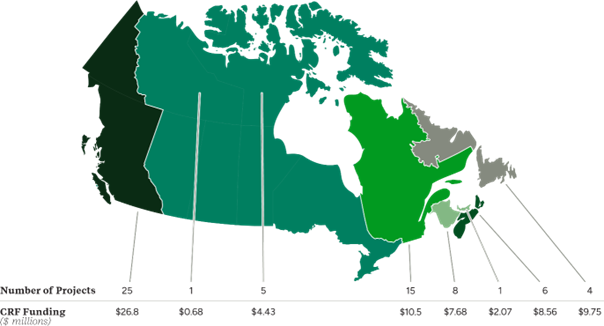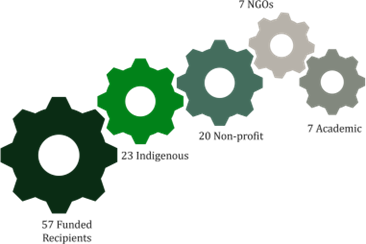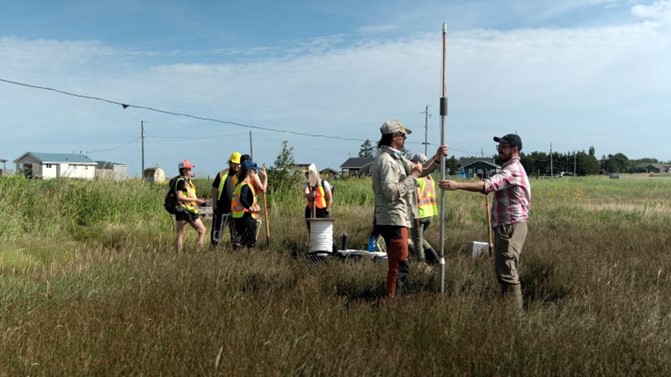Fisheries and Oceans Canada Coastal Restoration Fund Wrap-Up Report
Prepared for
Fisheries and Oceans Canada
Document title
Fisheries and Oceans Canada Coastal Restoration Fund
Document subtitle
Wrap-Up Report
Reference/project number
0698141
Date
November 15, 2023
Author
ERM
On this page
- 1. Overview of the coastal restoration fund
- 2. Coastal Restoration Fund 2017 to 2022 snapshot
- 3. Program results – key achievements
- 4. Aquatic Ecosystem Restoration Fund
- 5. References
List of tables
List of figures
- Figure 1: Number and dollar value (millions) of funded CRF projects, by region (DFO, 2020)
- Figure 4: Area of habitat restored through CRF projects by region (2017 to 2022) (DFO, 2022A)
- Figure 5: Former field supervisor with Souris wildlife uses silt gator to remove silt from riverbed and redistribute on the brush mat to expand salt marsh (image credit: PEI Watershed Alliance)
- Figure 6: Culvert replacement with concrete box culvert (image credit: Squamish River Watershed Society)
- Figure 7: Positive ecological impacts of projects (reported by survey respondents)
- Figure 8: Number of people trained through CRF projects by region (2017 to 2022) (DFO, 2022A)
- Figure 9: Field crew and volunteers preparing to dig runnels to restore the Brule Shore Salt Marsh. All work was done using shovels and buckets, and no machinery (image credit: Clean Foundation)
- Figure 10: Community members join a public engagement session at an automated lime doser (image credit: Nova Scotia Salmon Association)
Acronyms and abbreviations
- AERF
- Aquatic Ecosystems Restoration Fund
- CRF
- Coastal Restoration Fund
- DFO
- Fisheries and Oceans Canada
- NGO
- Non-governmental organization
- OPP
- Ocean Protection Plan
1. Overview of the Coastal Restoration Fund
Fisheries and Oceans Canada (DFO) launched the Coastal Restoration Fund (CRF) in May 2017, which provided a total of $75 million over 5 years to support projects that helped to restore coastal aquatic habitats. The CRF program was part of the Ocean Protection Plan's (OPP) commitment to preserve and restore marine ecosystems. The CRF was established to facilitate collaborations that contribute to developing and implementing coastal restoration plans, identifying restoration priorities, implementing restoration projects and addressing threats to marine species located on Canada's coasts.
The objectives of the CRF program were to:
- contribute to strategic planning and studies in key coastal areas
- rehabilitate aquatic habitats that contribute to the mitigation of stressors affecting marine life and their habitats
- contribute to the long-term sustainability of aquatic coastal habitats through monitoring and maintenance
- encourage and build local community capacity to maintain and restore aquatic habitats
Canada is home to the world's longest coastline linking 3 different oceans, including the Pacific, Arctic and Atlantic. These oceans are home to an immense web of marine life, generate oxygen and regulate the earth's temperature. The objectives of the CRF strongly reflected DFO's department of Aquatic Ecosystems' mandate to protect Canada's oceans, freshwater and aquatic ecosystems and species from the negative impact of humans and invasive species.
With the sunsetting of the CRF in 2022, this Wrap-Up Report is intended to highlight the key outcomes from the CRF and, in particular, how partnerships contributed to these results. The report has been informed by final program results and engagement with funding recipients. Out of 57 total funding recipients over the life of the CRF, 24 provided information on their projects and results through an electronic survey and 8 participated in interviews.
1.1 Call for proposals
Under the CRF, 2 calls for proposals were launched to support coastal restoration projects at the local and community level along Canada's coasts.
Eligibility
Each expression of interest was initially screened to determine if it met the minimum requirements to be considered an eligible CRF project (i.e., scope, funding request, objectives). Once a project was deemed eligible, it was then assessed to determine whether it would be considered a potential CRF project. The evaluation assessed:
- strategic value: does the project address regional coastal priorities?
- ecosystem value: does the project benefit ecological, biological and ecological services?
- technical/program specifics: does the project have the potential to succeed as presented?
The CRF supported a broad range of activities, including:
- feasibility and diagnostic studies
- environmental evaluations mapping
- rebuilding, restoring and rehabilitating aquatic habitat
- skills development including management and technical training
- monitoring of and reporting on projects
- construction, architectural, engineering, design and maintenance activities
Eligible groups included Indigenous organizations, conservation groups, community-based organizations, non-profit organizations and academic researchers/institutions across the country.
First call for proposals
In the initial Call for Proposals in May of 2017, DFO focused on multi-year projects with funding requests of $200,000 to $1,000,000 per year, aligning with national priorities. DFO prioritized projects that involved Indigenous or a broad range of partners to address coastal priority habitats that are important to the preservation and restoration of Canada's coastal ecosystems. Priority activities identified, included but are not limited to, restoring estuaries to improve fish passage, coastal watersheds and nearshore habitats (DFO, 2020). Under this Call for Proposals, DFO received over 186 expressions of interest requesting over $310 million in funding. Of these, a total of 76 were eligible and the program selected 32 projects to fund on all 3 coasts worth a total of $47.4 million (DFO, 2020). An additional 8 projects were funded worth a total of $10.2 million, which were selected from the remaining eligible projects in the initial Call for Proposals (DFO, 2020).
Second call for proposals
The second Call for Proposals, initiated in November 2018, was developed to allocate the remaining CRF funding, focusing on regional priorities. As such, DFO took a more targeted approach and requested that regions conduct outreach to identify regional priorities. Regional priorities included restoring fish habitats to benefit specific fish species in each region (DFO, 2020). DFO shifted its focus to projects with funding requests of $100,000 to $500,000 per year for 3 years. Following the second Call for Proposals, DFO received an additional 86 expressions of interest. Of these, DFO identified a total of 57 as eligible projects and 24 projects were selected for funding worth a total of $13.6 million (DFO, 2020).
1.2 Funding for selected projects
The CRF funded 64 projects, over both Calls for Proposals totaling $70.5 million Footnote 1 shown by region in Figure 1 Footnote 2, with the largest number and value of projects delivered in the Pacific Region.
A total of 57 recipients received funding. Some organizations led on more than one project. Funding recipients included a range of organizations, including Indigenous organizations, non-profit organizations, non-governmental organizations (NGOs) and academic institutions, as outlined in Figure 2. Of the 57 funded recipients, Indigenous organizations represented the largest number.
Of the 64 funded projects, approximately:
- 55% addressed the need to improve fish passage for migration, including marine and freshwater environments, for spawning and rearing grounds for a variety of fish
- 40% aimed to mitigate historical anthropogenic modifications to coastlines
- 20% conducted studies on the landscape to determine restoration needs (DFO, 2020)Footnote 3
2. Coastal Restoration Fund 2017 to 2022 snapshot
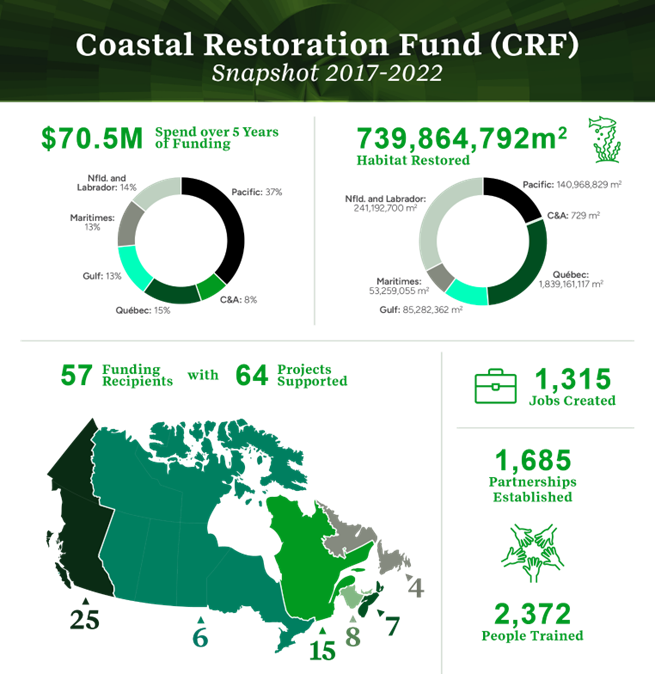
Coastal Restoration Fund 2017 to 2022 snapshot
Long description
Spending over 5 years totals $70.5 million:
- Pacific (BC): 37%
- Central (ON) and Arctic: 8%
- Quebec: 15%
- Gulf (PEI): 13%
- Maritimes (NS and NB): 13%
- Newfoundland and Labrador: 14%
Habitat Restored totals 739,864,792 square meters, and breakdown by region:
- Pacific: 140,968,829 square meters
- Central and Arctic: 729 square meters
- Quebec: 1,839,161,117 square meters
- Gulf: 82,282,362 square meters
- Maritimes: 53,259,055 square meters
- Newfoundland and Labrador: 241,192,700 square meters
57 Funding recipients with 64 projects supported
Map with number of projects divided by region:
- Pacific: 25
- Central and Arctic: 6
- Quebec: 15
- Gulf: 7
- Maritimes: 8
- Newfoundland and Labrador: 4
1,315 jobs created
1,685 partnerships established
2,372 people trained
3. Program results – key achievements
DFO's contribution of $70.5 million through the CRF enabled 57 organizations to undertake a total of 64 projects over the 5-year funding period from all DFO's administrative regions including:
- Pacific
- Central and Arctic
- Québec
- Gulf
- Maritimes
- Newfoundland and Labrador regions
Of the recipients surveyed and interviewed, 95% reported that their CRF project was successful in meeting its objectives set out in their contribution agreement with DFO. Recipients highlighted a broad range of successful outcomes and associated benefits including ecosystem improvements, enhancing impactful partnerships, increasing organizational and community capacity and building community education and awareness for the rehabilitation of coastal aquatic ecosystems.
The CRF's focus on collaborative approaches through partnership supported recipients' ability to establish and foster meaningful partnerships with Indigenous governments and organizations, academic institutions, communities, environmental or conservation groups, industry, funding institutions and various levels of government. 717 Indigenous governments and organizations were reported to be directly involved in CRF projects over the 5-year funding period in various capacities, including leadership of projects (DFO, 2022a). Over the funding period it was reported that a total of 1,685 partnerships were created to support CRF projects (DFO, 2022a). Recipients reported many direct benefits resulting from these partnerships including information and knowledge-sharing and access to skills and expertise to achieve the goals and objectives of the project. A majority of recipients noted that the partnerships created through the CRF have continued beyond the life of the CRF and have contributed to the sustainability of project results.
Primary ecosystem improvements that were reported by surveyed and interviewed recipients of the CRF include:
- a range of habitat restoration improvements, which have improved marine life populations and increased fish productivity for:
- new coastal habitat creation
- rehabilitated spawning and rearing grounds
- revegetation of riparian zones
- removal of subtidal debris
- a range of physical restoration measures including shoreline stabilization measures to prevent coastal erosion and barrier removal to support habitat connectivity
- a range of monitoring activities that allowed for adaptive management and improved ecosystem function including water quality and temperatures, sediment quality and carbon sequestration
CRF recipients also reported the significant socio-economic benefits that have resulted from the funded projects, including:
- capacity increase of their own organization
- community capacity improvements through increased education and awareness and hands-on experience
- recreational improvements
- job creation
It was reported that a total of 1,315 paid positions were created and 2,372 people were trained to improve technical and soft skills (DFO, 2022a).
CRF recipients widely reported that their project is expected to sustain its results beyond the life of the funding. Contributing factors to the sustainability of results that CRF recipients reported include their sustained partnerships, increased organizational capacity, monitoring and adaptive management efforts, restoration activities leading to nature being able to sustain itself over time and building of community buy-in to conservation efforts to become stewards of their local ecosystems.
3.1 The impact of partnerships
“We would not have been able to accomplish the work we completed without the support, labour, and good relationships we had with our CRF partners.”
The collaborative approach of the CRF program resulted in newly established and strengthened partnerships which brought tremendous value to projects and created long-term impacts.
In total, 1,685 partnerships were reported to have contributed to projects in some way throughout the duration of the CRF (DFO, 2022a). From the sample of responses collected through the survey, Indigenous governments or organizations, environmental or conservation groups and the federal government are the most reported types of partners:
- 12 Indigenous governments or organizations
- 11 environmental or conservation groups
- 10 federal government
- 7 communities
- 7 industry
- 7 provincial or territorial government
- 6 municipal government
- 5 academic institutions
- 3 foundation or other funding institution
3.1.1 Value of partnerships to projects
“The most important part of our partnerships was the knowledge sharing. […] Having the opportunity to gather expertise from various organizations was integral to the success of our project.”
Partnerships created opportunities for information and knowledge sharing, which supported in developing awareness, understanding and skills to deliver projects informed by diverse perspectives and experiences. The vast knowledge and skills leveraged because of partnerships also increased the capacity to meet the objectives of the CRF and expand impact.
Across all regions, the benefits of this approach reported by survey and interview respondents included:
- Knowledge sharing: Organizations shared information with one another through discussions, shared platforms (like summits and conferences) and working groups throughout the duration of the projects. For example, a working group was formed in the Arctic Region with Indigenous community members and organizations, academics, government officials and various funders. The working group identified the challenges of coastal restoration around Hudson Bay and James Bay, which they were subsequently able to address bilaterally. The insights gained helped organizations design and deliver projects that were informed by lessons learned and best practices.
- Access to skills and expertise: Organizations leveraged partnerships to fill gaps in skills and expertise that otherwise would have prevented them from delivering on their restoration projects. An organization in the Gulf Region indicated that they partnered with a local fabricator to build a dredging mechanism, which enabled them to drastically accelerate their project timelines compared to if they had relied on natural processes.
- Network creation: The CRF created an impetus for organizations to come together and build networks with other likeminded organizations, which resulted in improved capacity to implement restoration solutions. An organization in the Maritimes Region highlighted that they hosted networking opportunities for project partners to share knowledge of salt marsh ecology, restoration design and planning, data management and community engagement through project partner meetings and training workshops.
- Local knowledge and participation: Working with local and Indigenous partners increased knowledge of local environmental and social factors, ensured interests were heard in planning and resulted in increased participation from community members.
- Greater impact: Collaboration across a wide range of organizations and jurisdictions allowed for large-scale delivery of project activities and helped organizations to navigate regulatory requirements.
3.1.2 Evolution of partner relationships and long-term impacts
Not only did partnerships strengthen restoration efforts through CRF projects, but in many cases evolved into relationships with lasting impacts. Recipients noted that partnerships developed trust and understanding by working together on common goals. In some cases, new partnerships were formalized beyond the scope of the CRF and are expected to result in continued collaboration.
Key takeaways from survey and interview respondents include:
- both new and old partnerships were leveraged for CRF projects
- in many cases, partners worked together throughout each stage of a project, including planning, delivery and closing
- working towards common objectives over multiple years strengthened relationships and developed trust that will last for years to come
- some partnerships were formalized to ensure restoration activities will continue
- relationships with Indigenous groups were strengthened and survey respondents reported that engagements with Indigenous groups were more meaningful than they had been beforehand
“Partnering allowed our organization to gain perspective and knowledge from all sides of coastal restoration […] many of the issues identified have been addressed bilaterally with the involved parties.”
“The relationships strengthened throughout the lifecycle of the project […] built mutual trust and respect. Working together toward common goals also contributed to the strength of the relationship.”
3.2 Ecosystem improvements
The overarching objective of the CRF was to restore coastal aquatic habitats. CRF projects were expected to restore approximately 650 million m2 of aquatic habitat, however, actual results surpassed the forecasted restored area and CRF projects restored a total area of approximately 739,864,792m2 of aquatic habitat across Canada's coastlines (DFO, 2022a). As shown in Figure 4 below, the Newfoundland and Labrador Region and the Québec Region contributed significantly to aquatic habitat restoration. Restoration activities have led to improvements of aquatic habitat (including spawning and rearing grounds), ecosystem function and culturally significant species.

Figure 4: area of habitat restored through CRF projects by region (2017 to 2022) (DFO, 2022A)
Long description
Pie chart showing area of habitat restored, in square meters, through CRF projects by region:
- Newfoundland and Labrador: 241,192,700
- Pacific: 140,968,829
- Central and Arctic: 729
- Quebec: 219,161,117
- Gulf: 85,282,362
- Maritimes: 53,259,055
3.2.1 Restoration activities
The types of activities conducted by CRF recipients varied but generally fell into the following categories:
- habitat restoration
- shoreline stabilization
- barrier removal
- monitoring and mitigation
Examples of projects highlighting each of these activities, as described by survey and interview respondents, include:
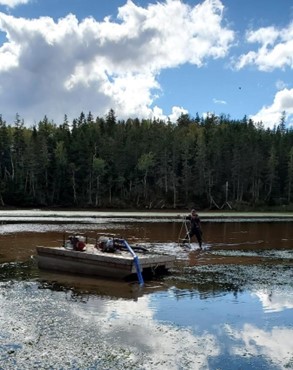
Figure 5: former field supervisor with Souris wildlife uses silt gator to remove silt from riverbed and redistribute on the brush mat to expand salt marsh. © PEI Watershed Alliance

Figure 6: Culvert replacement with concrete box culvert. © Squamish River Watershed Society
- Habitat restoration
- Newfoundland and Labrador Region: Deployed artificial reefs (that is, artificial reef domes and layer cake) and rehabilitated degraded eelgrass beds to mitigate human stressors and restore aquatic habitat.
- Maritimes Region: Realigned and decommissioned dyke infrastructure at multiple sites in the Bay of Fundy to restore tidal wetland (that is, salt marsh) habitat (Figure 5).
- Pacific Region: Dredged marine wood debris, capped exposed wood waste with clean wood waste and sand and planted eelgrass to restore coastal log handling sites.
- Shoreline stabilization
- Québec Region: Implemented plant engineering techniques (that is, the planting of lyme grass and bioengineering) to protect coastal habitats and prevent erosion through bank stabilization.
- Central and Arctic Region: Planted native species to stabilize coastline affected by permafrost thaw slumping to mitigate the effects of erosion on nearshore aquatic habitats.
- Gulf Region: Narrowed and deepened a channel in a watershed where it came through the estuary. Coir fiber logs were used to stabilize the bank and employ erosion control to expand the marsh.
- Barrier removal
- Pacific Region: Created breaches in 8-kilometre jetties and training walls to remove physical barriers and improve estuarine processes and juvenile salmon migration (Figure 6).
- Québec Region: Removal of a bridge blocking a section of a key watershed and revegetation of the area improved connectivity between the various channels of the barachois and its function as a flood-absorption zone.
- Maritimes Region: Replaced dilapidated, undersized culverts that were acting as a barrier to fish passage with a bridge to allow for slower moving water, does not become dry during low tides and less likely to trap debris causing congestion.
- Monitoring and mitigation
- Pacific Region: Monitored using biophysical, photo point and tagging methods to understand the improvements of water conditions, vegetation growth and fish movement. Continuous monitoring allowed for adaptive management to ensure success of the project.
- Central and Arctic Region: Monitored ground temperatures to understand the effectiveness of revegetation of native plants species to mitigate coastal erosion.
- Maritimes Region: Identified early signs of light erosion during wintertime monitoring. Used adaptive management and took a living shoreline approach using natural, biodegradable materials (that is, logs, branches and straw bales) to stabilize the soil and prevent further erosion.
3.2.2 Ecological benefits
Projects funded by the CRF had many positive ecological impacts. As reported by survey respondents, CRF projects had the most positive impacts on aquatic habitat and ecosystem function. However, these were also closely connected to culturally significant species, spawning/rearing grounds and habitat connectivity (Figure 7).

Figure 7: positive ecological impacts of projects (reported by survey respondents)
Long description
Bar graph showing positive ecological impacts of projects, by number of projects, as reported by survey respondents:
- culturally significant species: 14
- threatened or endangered species: 9
- ecosystem function: 15
- spawning or rearing grounds: 14
- habitat connectivity: 14
- aquatic habitat: 15
- marine life population: 12
While these impacts were seen across all regions, the ecological benefits and outcomes resulting from the restoration activities varied and a sample are highlighted below:
- Aquatic habitat (including spawning and rearing grounds)
- Maritimes Region: Observed increased Atlantic Salmon spawning activity at several of the restored sites and Wood Turtle nesting along the shore where beaches were formed along the narrowed channel river.
- Pacific Region: Planting native coniferous species along the shoreline provided large woody debris inputs into the stream channel to create habitat.
- Gulf Region: Site restoration improved the protection of smelt spawning grounds and the upstream migration of smelt (and other anadromous species, such as alewife).
- Newfoundland and Labrador Region: Artificial reef and eelgrass restoration contributed to the increase in the juvenile lobster population through improved nursing habitat.
- Central and Arctic Region: Riparian species revegetation mitigated the effects of erosion on nearshore aquatic habitat.
- Gulf Region: Brush mattresses of coniferous trees helped to restore riparian vegetation and prevent erosion of aquatic habitat by intercepting sedimentation.
- Ecosystem function
- Maritimes Region: Use of automated lime dosers in watersheds dealing with legacy of impacts of acid rain helped offset the acidity and recover important nutrients. Salmon populations recovered due to the improved ecosystem function.
- Pacific Region: The breaches created have reconnected the Fraser River with its delta and have restored the natural movement of freshwater, fine sediment and nutrients to restore natural ecosystem processes.
- Maritimes Region: 30.1 hectares of restored tidal wetlands increased carbon sequestration function.
- Culturally significant species
- Québec Region: Adding eel ramps allowed the free movement of American eels and their access to lakes, including 700 hectares of quality habitat for the culturally significant and at-risk species.
- Pacific Region: Recreating a former eelgrass meadow in the estuary restored an important Salmon stream with high ecological and culture value for local First Nations.
- Maritimes Region: Installation of a Denil fishway allowed for stranded Gaspereau to move upstream and access the fish ladder to critical habitat.
“The eel ramps installed on these 4 upstream obstacles now allow the free movement of eels and their access to lakes, including more than 700 hectares of quality habitat for this species at risk that is culturally significant for the Mi'gmaq and Wolastqey communities.”
“30.1 hectares of tidal wetland were restored, providing increased ecosystem services including carbon sequestration, and habitat for fish, invertebrates and vertebrate use as part of their life cycles.”
3.3 Socio-economic benefits
CRF projects contributed to long-term impacts for communities and increased capacity to develop and deliver further restoration activities. Overall, CRF recipients reported 2,372 people were trained through CRF projects to support coastal restoration in various ways. Socio-economic benefits resulting from CRF projects included organizational capacity, community capacity and job creation, as described in further detail below.
3.3.1 Capacity building
“Having the ability to train and retain students was so important to the capacity of our organization, but also to the province. Being able to train local people is good for companies that want to invest in Newfoundland and Labrador. It really helps our economy.”
Based on survey results and interview responses, CRF funded projects led to an increase in capacity for both recipient organizations and communities.
Organizational capacity building
CRF projects supported increased capacity building within recipient organization. Survey and interview respondents highlighted that:
- organizations increased the number of staff during CRF projects, resulting in the ability to deliver on CRF project objectives as well as broader organizational objectives.
- teams accessed and learned how to use technologies that would not otherwise have been available to them, which created the ability to leverage this knowledge in future projects.
- organizations developed knowledge and expertise which can be applied to future restoration efforts. For example, organizations leveraged their partnerships to build technical expertise and other skills, such as project management, communication and critical thinking.
Community capacity building
CRF projects supported increased education and awareness of conservation, volunteer opportunities, training and hands-on work experience for many community members.
Education and awareness
Projects involved activities to engage communities on topics related to coastal restoration, including:
- raising awareness about coastal restoration and providing project updates through news and social media channels.
- targeted outreach and educational activities, sometimes involving visits to restoration sites as part of interactive learning. Through a project in the Pacific Region, one survey respondent shared that restoration sites served and continue to serve as “living labs” to monitor progress and share lessons learned with interested stakeholders.
- two-way exchanges between organizations and community members to gather local information and respond to questions related to restoration activities (like through roundtable discussions).
Topics covered during these activities included coastal erosion, salt marsh ecology, the importance of connected habitats, how infrastructure impacts salmon populations, the significance of eelgrass and its ecosystem services, monitoring mechanisms and more.
Hands-on experience
“The project provided training opportunities for members of the public, increasing people's knowledge and understanding of the importance of salt marsh habitat and the impacts of climate change on coastal communities. The 3 restoration sites […] served as an opportunity to showcase viable nature-based solutions that can help make coastal communities resilient to the impacts of climate change.”
Projects provided opportunities for individuals to gain experience and learn through volunteer opportunities. Some volunteers were involved throughout the duration of a project, while others participated in one-time events.
Volunteers conducted various hands-on activities, including riparian restoration, eelgrass planting, assessing salmon habitats, monitoring of living species, installing equipment and more.
Projects also provided other types of capacity building opportunities, such as knowledge, skills and formal technical training for the organization's employees, consultants, interns and community members including youth and Indigenous groups. Some examples of training opportunities included the use of monitoring equipment, the use of ghost gear retrieval equipment, environmental monitoring and marine aquatic technician training. The reported number of people trained through CRF projects is outlined in Figure 8.
Students also benefited uniquely through these opportunities by gaining hands-on experience which allowed them to apply their knowledge in real-world applications, develop further skills and prepare them for future opportunities. In some cases, students even focused their master's or PhD thesis on the project.
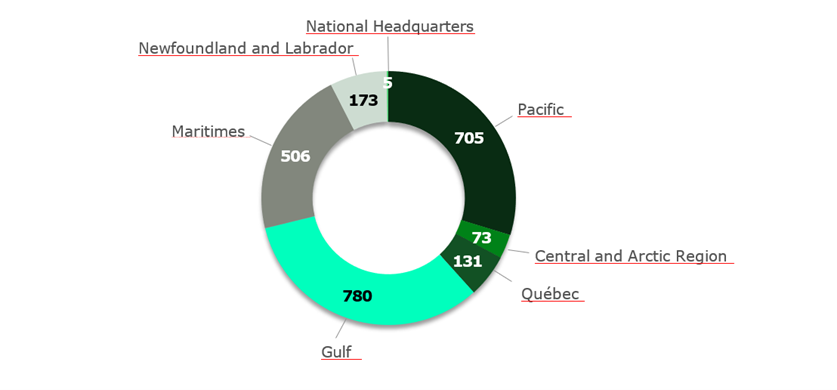
Figure 8: number of people trained through CRF projects by region (2017 to 2022) (DFO, 2022A)
Long description
Pie chart showing the number of people trained by region through CRF projects (2017-2022):
- Newfoundland and Labrador: 173
- National Headquarters: 5
- Pacific: 705
- Central and Arctic: 73
- Québec: 131
- Gulf: 780
- Maritimes: 506
3.3.2 Job creation
“Our project provided training and employment opportunities to Haida and other local residents, including youth. It also provided education and a voice to the community on the widespread issue of environmental damage around these sites.”
CRF funding resulted in economic value to communities through short-term and long-term job creation and other indirect benefits. In total, it was reported that 1,315 jobs were created throughout the duration of the CRF, as detailed in Table 1 (DFO, 2022a).
Employment opportunities included full-time jobs, internships, student opportunities and work for contractors and consultants, which were created for technical expertise, research, administrative and operational purposes. Survey respondents highlighted the benefits of job creation for young people, with many involved throughout projects and beyond. Some volunteers, interns and summer students also became long-term employees after the conclusion of projects.
Other economic benefits include the purchase of local products and services, expanded seasonal operations for companies, important long-term contracts for NGOs, improved business outcomes due to restoration of marine species' habitats and increased income and scope of employment opportunities for individuals.
| 2017 to 2018 | 2018 to 2019 | 2019 to 2020 | 2020 to 2021 | 2021 to 2022 | Total |
|---|---|---|---|---|---|
| 71 | 285 | 433 | 359 | 167 | 1,315 |
3.3.3 Other impacts of significance to communities
The CRF had other positive socio-economic benefits to communities, including:
- cultural significance: Cultural benefits for Indigenous groups included reconnection to significant spaces, increased traditional harvesting, improvements for species of importance, meaningful participation of communities in planning and delivery and increased mutual trust between Indigenous groups and CRF recipient organizations.
- recreational activities: Projects resulted in increased recreational use of waterways and surrounding lands, benefits for fishers due to increased populations and improvements to access, expressed appreciation from community members and more educational opportunities.
- positive environmental effects: Some survey respondents also reported environmental benefits outside the scope of the CRF. Examples include increased knowledge to inform sustainable fisheries and land-use management and reduced flooding due to improved flow of a river system.
3.4 Sustainability of project results
95% of the CRF recipients that were surveyed or interviewed reported that their projects were successful in meeting the objectives of their contribution agreements with DFO. 68% of the CRF recipients surveyed or interviewed reported that their CRF projects continued once CRF funding ended. Contributing factors to the sustainability of project results include increased organizational capacity, monitoring and adaptive management, self-sustaining ecosystem functions, community awareness and social license and the sustainability of partnerships.
3.4.1 Organizational capacity
In addition to increased organizational capacity contributing to the socio-economic benefits of the CRF projects, organizational capacity was stated as a key driver in the sustainability of project results. Through the CRF funding received, recipient organizations increased access to staff, expertise and skills and specialized equipment that have outlasted the life of the CRF project and contribute to ongoing restoration efforts. The 5-year, stable funding allowed organizations to develop their technical expertise in areas such as habitat restoration, water and soil sampling, monitoring techniques and the use of modern equipment, in addition to soft skills.
The CRF helped organizations capitalize on opportunities for additional multi-year funding from other sources by demonstrating their ability to be successful in large-scale projects.
“The CRF program provided a fundamental shift and acceleration for coastal ecosystem restoration in the Atlantic Provinces and has built local and regional capacity to do this important work. It provided the opportunity to demonstrate our ability to be successful in future funding applications by showcasing our work through CRF.”
3.4.2 Monitoring and adaptive management
Although many sites are still evolving due to the long-time horizon of restoration work, signs of improvement to coastal habitats and species have already been seen. In some cases where results varied in different areas, evaluation is being undertaken to better understand the influencing factors and how these can be considered moving forward. Some funding recipients plan to continue monitoring and adaptive management to measure changes, evaluate long-term benefits and continue restoration efforts. Multiple projects implemented long-term plans for student monitoring to continue this sustainably.
3.4.3 Self-sustaining ecosystem function
Several funding recipients reported positive expectations for ecosystem improvements, with restoration activities supporting nature's ability to sustain itself over time. Some examples include:
- Pacific Region: Restoration of natural ecosystem processes will lead to a healthy delta. The creation of openings in fish passage barriers will allow creation of channels to further expand habitat.
- Maritimes Region: Movement patterns of Atlantic salmon will improve and colonization of the reefs by rock weed will take 12+ months, which will realize more benefits for fish species. The reefs will continue to develop macroalgae communities which will enhance their effectiveness.
- Arctic Region: Net exchange from smaller to larger net size will allow juvenile fish to escape and grow to maturity over time to create different generations within the stock.
- Québec Region: Monitoring shows that 5 kilometres of previously eroding coastal habitat is now stabilized and will protect the littoral habitat from damage in future storms.
Additional capacity gained through projects also contributed to restoration activities beyond the funding scope of the CRF that are expected to further sustain ecosystem functions.
3.4.4 Community awareness and social license
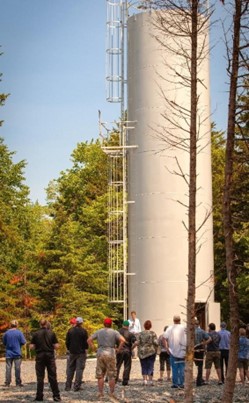
Figure 10: community members join a public engagement session at an automated lime doser. © Nova Scotia Salmon Association
Engagement with the public resulted in increased awareness and involvement from many local groups and individuals. Through engagement events, media releases, workshops, site visits and more, funding recipients provided opportunities for learning and discussion, which ultimately contributed to building relationships and social license for both their CRF project and organization. This was an important part of gaining support throughout the duration of the CRF and resulted in more people becoming stewards of the environment beyond the conclusion of projects.
Some survey respondents also shared that their initiatives gained support from governments and political leaders. In one case, a provincial Minister attended an event and increased the exposure of the project which improved opportunities to receive further funding. In another example, provincial policies on licensing requirements were improved for ecological benefits due to issues raised by projects.
Due to the success of public engagement efforts and their ability to transform landscapes, projects in the Maritimes have since become case studies for various national and international guidance documents.
3.4.5 Sustainability of partnerships
“We will continue our partnerships between Inuit and Cree communities to steward the region together.”
While not all partnerships continued after the conclusion of the CRF, many did. For example, some partners formalized groups that meet and work towards common goals and others have secured other sources of funding together for additional restoration projects. Organizations have particularly valued continuing partnerships with Indigenous groups.
Overall, the networks that funding recipients were able to build throughout the duration of the CRF have allowed them to pursue future work and expand impact with higher capacity and improved reputation.
4. Aquatic Ecosystem Restoration Fund
Following the sunsetting of the CRF in March 2022, DFO launched the Aquatic Ecosystems Restoration Fund (AERF) as part of the renewal of the national OPP in July 2022. The AERF is a renewal and expansion of the CRF program and will provide $75 million over the next 5 years from 2022 to 2027 to support aquatic restoration. The AERF built on the existing framework of the CRF and expanded its approach to help address root causes of impacts to coastal and marine environments. The AERF is supporting efforts that protect and restore coastal as well as marine areas through the following objectives:
- contributing to strategic planning and responding to restoration priorities
- supporting restoration and rehabilitation of aquatic habitats and their long-term sustainability
- educating the public on the impacts of human behaviour on aquatic habitats
- supporting co-benefits of aquatic restoration activities
- encouraging and building local community capacity
DFO gathered input from DFO regional staff and CRF recipients through various forums to refine the objectives and priorities of the AERF, including through the following engagements:
- DFO's CRF Workshop held in March 2020, which was designed to allow CRF recipients an opportunity to connect and share experiences, successes and challenges relating to their respective CRF projects. Recipients showcased learnings and new initiatives that contributed to the design of the AERF.
- Three virtual meetings between Indigenous representatives and DFO held in June 2022 to provide Indigenous groups with a platform to share their views and recommendations pertinent to the design and development of the AERF.
- DFO's National Survey conducted in 2022 with the goal of seeking Canadian's views on the AERF's future scope, mandate, priority areas and activities, areas of improvement for program delivery and general views held on aquatic restoration in Canada.
Some interviewees and survey respondents reported that due to the success of the CRF, recipients have pursued funding under the AERF to continue their aquatic restoration efforts. Many survey and interview respondents noted the importance of stable, long-term funding to achieve sustainable results. With the CRF to pave the way, the AERF will provide an opportunity for recipients to continue to build upon their aquatic restoration efforts and to further foster and enhance meaningful partnerships.
“We received AERF funding to continue the same type of restoration work and will continue to work with our partners to build on successes.”
“We had opened fish passage for Atlantic Salmon but at the time, we were not as in tune of the potential for further distribution of invasive species. We have now incorporated that consideration into the next iteration of our project through AERF.”
5. References
- Fisheries and Oceans Canada (DFO). 2022a. CRF Statistics (2017-2022).
- Fisheries and Oceans Canada (DFO). 2022b. Summary Report of Three Virtual Meetings Between Indigenous Representatives and the Department of Fisheries and Oceans Canada (DFO).
- Fisheries and Oceans Canada (DFO). 2022c. National Survey Report 2022.
- Fisheries and Oceans Canada (DFO). 2020. Evaluation of the Coastal Restoration Fund: Final Report. Retrieved from Evaluation of the Coastal Restoration Fund.
- MODUS Planning, Design and Engagement. 2020. Workshop Summary Report: Department of Fisheries and Oceans Coastal Restoration Fund Workshop. Vancouver: prepared for DFO.
- Date modified:

